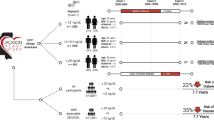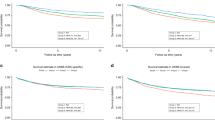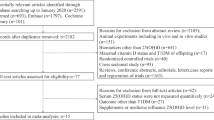Abstract
Background
To examine the association of serum 25-hydroxyvitamin D (25[OH]D) with colorectal cancer (CRC) risk in adults with type 2 diabetes (T2D).
Methods
Using UK Biobank data, this study included 18,453 adults with T2D. Serum 25(OH)D concentrations were determined by the chemiluminescent immunoassay method. A Cox proportional hazards model was used to calculate hazard ratios (HRs) and 95% confidence intervals (CIs) for CRC outcomes.
Results
During a median follow-up of 8.8 years, there were 284 incident CRC cases. Compared with adults with serum 25(OH)D concentrations <25.0 nmol/L, the adjusted HRs (95% CIs) for lower to higher serum 25(OH)D concentrations (25.0 to <50.0, 50.0 to <75.0, and ≥75.0 nmol/L) were 0.61 (0.46–0.82), 0.50 (0.34–0.74), and 0.53 (0.30–0.94), respectively (Ptrend = 0.001). The risk of CRC decreased by 19.0% for per 1-SD increment in serum 25(OH)D concentrations. A nonlinear association of serum 25(OH)D concentrations with CRC risk was observed using a restricted cubic spline analysis (P nonlinearity = 0.002).
Conclusions
Higher serum 25(OH)D concentrations were significantly and nonlinearly associated with a lower risk of CRC. These findings highlight the potential benefits of maintaining adequate vitamin D levels in CRC prevention among adults with T2D.
This is a preview of subscription content, access via your institution
Access options
Subscribe to this journal
Receive 24 print issues and online access
$259.00 per year
only $10.79 per issue
Buy this article
- Purchase on Springer Link
- Instant access to full article PDF
Prices may be subject to local taxes which are calculated during checkout

Similar content being viewed by others
Data availability
Data are available in a public, open access repository. The UK Biobank data are available from the UK Biobank on request (www.ukbiobank.ac.uk/).
References
Chatterjee S, Khunti K, Davies MJ. Type 2 diabetes. Lancet. 2017;389:2239–51. https://doi.org/10.1016/S0140-6736(17)30058-2
Saeedi P, Petersohn I, Salpea P, Malanda B, Karuranga S, Unwin N, IDF Diabetes Atlas Committee. Global and regional diabetes prevalence estimates for 2019 and projections for 2030 and 2045: results from the International Diabetes Federation Diabetes Atlas, 9th edition. Diabetes Res Clin Pract. 2019;157:107843. https://doi.org/10.1016/j.diabres.2019.107843
Harding JL, Shaw JE, Peeters A, Davidson S, Magliano DJ. Age-specific trends from 2000-2011 in all-cause and cause-specific mortality in type 1 and type 2 diabetes: a cohort study of more than one million people. Diabetes Care. 2016;39:1018–26. https://doi.org/10.2337/dc15-2308
Gregg EW, Cheng YJ, Srinivasan M, Lin J, Geiss LS, Albright AL, et al. Trends in cause-specific mortality among adults with and without diagnosed diabetes in the USA: an epidemiological analysis of linked national survey and vital statistics data. Lancet. 2018;391:2430–40. https://doi.org/10.1016/S0140-6736(18)30314-3
Pearson-Stuttard J, Bennett J, Cheng YJ, Vamos EP, Cross AJ, Ezzati M, et al. Trends in predominant causes of death in individuals with and without diabetes in England from 2001 to 2018: an epidemiological analysis of linked primary care records. Lancet Diabetes Endocrinol. 2021;9:165–73. https://doi.org/10.1016/S2213-8587(20)30431-9
Holick MF. Vitamin D deficiency. N Engl J Med. 2007;357:266–81. https://doi.org/10.1056/NEJMra070553
Weinstein SJ, Purdue MP, Smith-Warner SA, Mondul AM, Black A, Ahn J, et al. Serum 25-hydroxyvitamin D, vitamin D binding protein and risk of colorectal cancer in the prostate, lung, colorectal and ovarian cancer screening trial. Int J Cancer. 2015;136:E654–64. https://doi.org/10.1002/ijc.29157
McCullough ML, Zoltick ES, Weinstein SJ, Fedirko V, Wang M, Cook NR, et al. Circulating vitamin D and colorectal cancer risk: an international pooling project of 17 cohorts. J Natl Cancer Inst. 2019;111:158–69. https://doi.org/10.1093/jnci/djy087
Wu K, Feskanich D, Fuchs CS, Willett WC, Hollis BW, Giovannucci EL. A nested case control study of plasma 25-hydroxyvitamin D concentrations and risk of colorectal cancer. J Natl Cancer Inst. 2007;99:1120–9. https://doi.org/10.1093/jnci/djm038
Dou R, Ng K, Giovannucci EL, Manson JE, Qian ZR, Ogino S. Vitamin D and colorectal cancer: molecular, epidemiological and clinical evidence. Br J Nutr. 2016;115:1643–60. https://doi.org/10.1017/S0007114516000696
Jenab M, Bueno-de-Mesquita HB, Ferrari P, van Duijnhoven FJ, Norat T, Pischon T, et al. Association between pre-diagnostic circulating vitamin D concentration and risk of colorectal cancer in European populations:a nested case-control study. BMJ. 2010;340:b5500. https://doi.org/10.1136/bmj.b5500
Otani T, Iwasaki M, Sasazuki S, Inoue M, Tsugane S, Japan Public Health Center-Based Prospective Study Group. Plasma vitamin D and risk of colorectal cancer: the Japan Public Health Center-Based Prospective Study. Br J Cancer. 2007;97:446–51. https://doi.org/10.1038/sj.bjc.6603892
Tsilidis KK, Kasimis JC, Lopez DS, Ntzani EE, Ioannidis JP. Type 2 diabetes and cancer: umbrella review of meta-analyses of observational studies. BMJ. 2015;350:g7607. https://doi.org/10.1136/bmj.g7607
Rao Kondapally Seshasai S, Kaptoge S, Thompson A, Di Angelantonio E, Gao P, Sarwar N, et al. Diabetes mellitus, fasting glucose, and risk of cause-specific death. N Engl J Med. 2011;364:829–41. https://doi.org/10.1056/NEJMoa1008862
Wang H, Chen W, Li D, Yin X, Zhang X, Olsen N, et al. Vitamin D and chronic diseases. Aging Dis. 2017;8:346–53. https://doi.org/10.14336/AD.2016.1021
Lips P, Eekhoff M, van Schoor N, Oosterwerff M, de Jongh R, Krul-Poel Y, et al. Vitamin D and type 2 diabetes. J Steroid Biochem Mol Biol. 2017;173:280–5. https://doi.org/10.1016/j.jsbmb.2016.11.021
Wan Z, Guo J, Pan A, Chen C, Liu L, Liu G. Association of serum 25-hydroxyvitamin D concentrations with all-cause and cause-specific mortality among individuals with diabetes. Diabetes Care. 2021;44:350–7. https://doi.org/10.2337/dc20-1485
Giovannucci E, Harlan DM, Archer MC, Bergenstal RM, Gapstur SM, Habel LA, et al. Diabetes and cancer: a consensus report. Diabetes Care. 2010;33:1674–85. https://doi.org/10.2337/dc10-0666
Sudlow C, Gallacher J, Allen N, Beral V, Burton P, Danesh J, et al. UK biobank: an open access resource for identifying the causes of a wide range of complex diseases of middle and old age. PLoS Med. 2015;12:e1001779. https://doi.org/10.1371/journal.pmed.1001779
Eastwood SV, Mathur R, Atkinson M, Brophy S, Sudlow C, Flaig R, et al. Algorithms for the capture and adjudication of prevalent and incident diabetes in UK biobank. PLoS ONE. 2016;11:e0162388. https://doi.org/10.1371/journal.pone.0162388
Fry D, Almond R, Moffat S, Gordon M, Singh P. UK Biobank Biomarker Project: companion document to accompany serum biomarker data. Version 1.0. Stockport: UK Biobank, 2019. Available from: 21. http://biobank.ndph.ox.ac.uk/showcase/showcase/docs/serum_biochemistry.pdf
Carr PR, Weigl K, Jansen L, Walter V, Erben V, Chang-Claude J, et al. Healthy lifestyle factors associated with lower risk of colorectal cancer irrespective of genetic risk. Gastroenterology. 2018;155:1805–15.e5. https://doi.org/10.1053/j.gastro.2018.08.044
Hajizadeh M, Charles M, Johnston GM, Urquhart R. Socioeconomic inequalities in colorectal cancer incidence in Canada: trends over two decades. Cancer Causes Control. 2022;33:193–204. https://doi.org/10.1007/s10552-021-01518-x
Holick MF, Binkley NC, Bischoff-Ferrari HA, Gordon CM, Hanley DA, Heaney RP, et al. Endocrine society. Evaluation, treatment, and prevention of vitamin D deficiency: an Endocrine Society clinical practice guideline. J Clin Endocrinol Metab. 2011;96:1911–30. https://doi.org/10.1210/jc.2011-0385
Hernández-Alonso P, Boughanem H, Canudas S, Becerra-Tomás N, Fernández de la Puente M, Babio N, et al. Circulating vitamin D levels and colorectal cancer risk: a meta-analysis and systematic review of case-control and prospective cohort studies. Crit Rev Food Sci Nutr. 2023;1–17. https://doi.org/10.1080/10408398.2021.1939649
Huang D, Lei S, Wu Y, Weng M, Zhou Y, Xu J, et al. Additively protective effects of vitamin D and calcium against colorectal adenoma incidence, malignant transformation and progression: a systematic review and meta-analysis. Clin Nutr. 2020;39:2525–38. https://doi.org/10.1016/j.clnu.2019.11.012
Weinstein SJ, Yu K, Horst RL, Ashby J, Virtamo J, Albanes D. Serum 25-hydroxyvitamin D and risks of colon and rectal cancer in Finnish men. Am J Epidemiol. 2011;173:499–508. https://doi.org/10.1093/aje/kwq398
Manson JE, Cook NR, Lee IM, Christen W, Bassuk SS, Mora S, et al. Vitamin D supplements and prevention of cancer and cardiovascular disease. N Engl J Med. 2019;380:33–44. https://doi.org/10.1056/NEJMoa1809944
Chatterjee R, Fuss P, Vickery EM, LeBlanc ES, Sheehan PR, Lewis MR, et al. Vitamin D supplementation for prevention of cancer: the d2d Cancer Outcomes (D2dCA) Ancillary Study. J Clin Endocrinol Metab. 2021;106:2767–78. https://doi.org/10.1210/clinem/dgab153
Guo J, Sun C, Wang B, Ma K, Li F, Wang Y, et al. Associations between vitamin D and β-cell function and colorectal cancer-associated tumor markers in chinese type 2 diabetic patients with albuminuria. Clin Lab. 2019;65. https://doi.org/10.7754/Clin.Lab.2019.181111
Wimalawansa SJ. Vitamin D deficiency: effects on oxidative stress, epigenetics, gene regulation, and aging. Biology (Basel). 2019;8:30. https://doi.org/10.3390/biology8020030
Feldman D, Krishnan AV, Swami S, Giovannucci E, Feldman BJ. The role of vitamin D in reducing cancer risk and progression. Nat Rev Cancer. 2014;14:342–57. https://doi.org/10.1038/nrc3691
Chen A, Davis BH, Sitrin MD, Brasitus TA, Bissonnette M. Transforming growth factor-beta 1 signaling contributes to Caco-2 cell growth inhibition induced by 1,25(OH)(2)D(3). Am J Physiol Gastrointest Liver Physiol. 2002;283:G864–74. https://doi.org/10.1152/ajpgi.00524.2001
Boughanem H, Cabrera-Mulero A, Hernández-Alonso P, Clemente-Postigo M, Casanueva FF, Tinahones FJ, et al. Association between variation of circulating 25-OH vitamin D and methylation of secreted frizzled-related protein 2 in colorectal cancer. Clin Epigenetics. 2020;12:83. https://doi.org/10.1186/s13148-020-00875-9
Szymczak-Pajor I, Drzewoski J, Śliwińska A. The molecular mechanisms by which vitamin d prevents insulin resistance and associated disorders. Int J Mol Sci. 2020;21:6644. https://doi.org/10.3390/ijms21186644
Giammanco M, Di Majo D, La Guardia M, Aiello S, Crescimannno M, Flandina C, et al. Vitamin D in cancer chemoprevention. Pharm Biol. 2015;53:1399–434. https://doi.org/10.3109/13880209.2014.988274
Rammos G, Tseke P, Ziakka S. Vitamin D, the renin-angiotensin system, and insulin resistance. Int Urol Nephrol. 2008;40:419–26. https://doi.org/10.1007/s11255-007-9244-4
Yang X, Zhao H, Sui Y, Ma RC, So WY, Ko GT, et al. Additive interaction between the renin-angiotensin system and lipid metabolism for cancer in type 2 diabetes. Diabetes. 2009;58:1518–25. https://doi.org/10.2337/db09-0105
Gabryanczyk A, Klimczak S, Szymczak-Pajor I, Śliwińska A. Is vitamin d deficiency related to increased cancer risk in patients with type 2 diabetes mellitus? Int J Mol Sci. 2021;22:6444. https://doi.org/10.3390/ijms22126444
Acknowledgements
We thank the UK Biobank participants. This research has been conducted using the UK Biobank resource under application number 43795.
Funding
This work was supported by the National Natural Science Foundation of China (82060619), the China Postdoctoral Science Foundation funded project (2021M691456), the Science and Technology Programme of Guizhou Province (ZK[2021]495), the Doctoral Research Fund Project of Zunyi Medical University (F-947), Guangdong Province Universities and Colleges Pearl River Scholar Funded Scheme (2019), and the Construction of High-level University of Guangdong (G621331128). The funders had no role in the design and conduct of the study, in the collection, analysis, and interpretation of the data, or in the preparation, review, or approval of the manuscript.
Author information
Authors and Affiliations
Contributions
CM and J-JR contributed to the concept and design. J-JR, Z-HL, W-FZ, P-LC, Q-MH, X-MW, P-MG, and CM contributed to acquisition, analysis, or interpretation of data. J-JR and CM contributed to funding acquisition. J-JR, Z-HL, and W-FZ contributed to methodology. P-LC, Q-MH, and X-MW contributed to administrative, technical, or material support. J-JR and W-FZ wrote original draft. CM and P-MG contributed to supervision. All authors contributed to the analysis and interpretation of data and revise the article, and have approved the final version of the article. CM is the study guarantor and takes responsibility for the integrity of the data and the accuracy of the data analyses.
Corresponding authors
Ethics declarations
Competing interests
The authors declare no competing interests.
Ethics approval and consent to participate
The study was approved by the research ethics committee (UK Biobank 11/NW/0382) and all participants provided informed consent at baseline. Any additional ethical approval was adjudged unnecessary for the present study.
Consent for publication
Not applicable.
Additional information
Publisher’s note Springer Nature remains neutral with regard to jurisdictional claims in published maps and institutional affiliations.
Supplementary information
Rights and permissions
Springer Nature or its licensor (e.g. a society or other partner) holds exclusive rights to this article under a publishing agreement with the author(s) or other rightsholder(s); author self-archiving of the accepted manuscript version of this article is solely governed by the terms of such publishing agreement and applicable law.
About this article
Cite this article
Ren, JJ., Li, ZH., Zhong, WF. et al. Serum 25-hydroxyvitamin D concentrations and colorectal cancer incidence in adults with type 2 diabetes. Br J Cancer 129, 486–491 (2023). https://doi.org/10.1038/s41416-023-02323-w
Received:
Revised:
Accepted:
Published:
Issue Date:
DOI: https://doi.org/10.1038/s41416-023-02323-w



